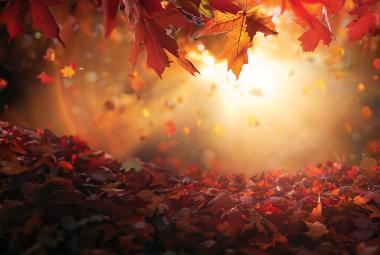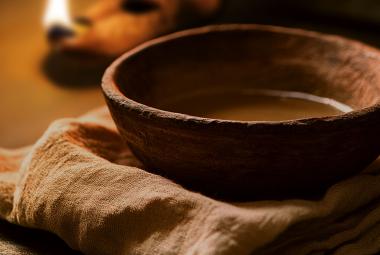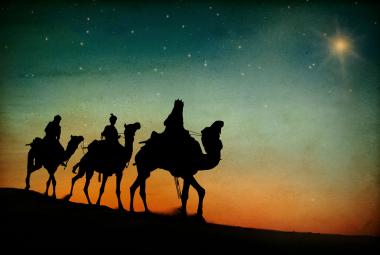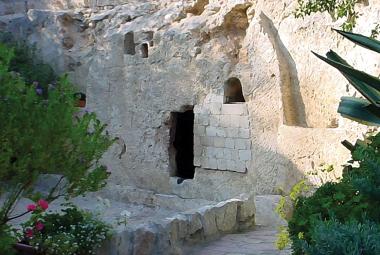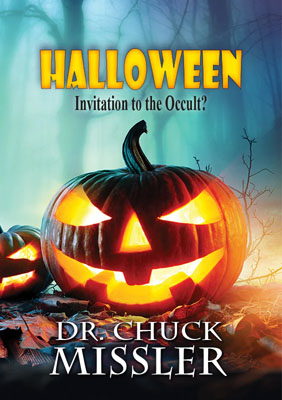Every year on the last day of October, American children paint their faces, color their hair, don gowns, capes and fuzzy suits, and traipse about from door-to-door collecting bags of candy. Their parents join them, visiting parties and high school haunted houses. Together, they carve crazy faces on pumpkins, cover apples with caramel, and work to win contests for the scariest or most creative costumes.
But why? How did this holiday originate? This night of orange and black offers opportunities for spooky fun, parties with Chex mix and candy corn, and faces wet from apple bobbing. It also offers opportunities for involvements that are genuinely dangerous as people willingly meddle with the occult when they would otherwise never do so. Every year, Christians are left wondering exactly how to handle this holiday that focuses so much on death.
We might not see witches’ cauldrons bubbling in local caves or Druids marching circles in the park, but it’s still easy to find remnants of our pagan past in the day-to-day walk through our world. Our days of the week and the months of the year are largely named after pagan gods from Roman and Teutonic traditions. We even find aspects of those old days at Christmas – the time of year we’ve dedicated to honoring the birth of our Lord Jesus Christ. I think most of us are sensitive to the fact that we are immersed in a pagan culture, and it’s become fascinating, and disconcerting, to watch as the world grows increasingly more open to the dark side.
Ancient pagan traditions have leaked through the centuries into the present day. The custom of kissing someone under the mistletoe can be traced back to druid beliefs about the connection of that plant to sexual potency. The term “druid” originally referred to a priest of the oak cult, by the way. Easter is the season we commemorate the death and resurrection of Christ, but all that business of chicks, baby rabbits, and eggs ties back to the Babylonian fertility religions and the goddess Astarte or Ishtar, from which “Easter” gets its name. The egg was a fertility symbol that originated in debauched fertility cults. We think of Easter egg hunts as fun activities for children. The original cult practices were anything but child-friendly. If we understand the rabbit as a symbol of fertility, we can understand how both eggs and rabbits became associated with Easter. Cadbury might give us bunnies that lay treasures of gooey chocolate wonder, but that strange idea that we take for granted - an Easter bunny hiding eggs - hearkens back to these ancient practices.
Our culture is filled with the vestiges of ancient paganism. The custom of giving out cigars at a baby’s birth may hail from the times when ancient Mayan fathers would blow tobacco smoke toward the sun god as an offering of thanks for a newborn child. June is a lovely time to hold weddings, so it’s no coincidence that June was named for Juno, the Roman goddess of marriage. Most aspects of the American wedding ceremony can be traced to ancient pagan customs, including the bride’s white dress and veil, the exchanging of wedding rings and the father’s giving away the bride. Our childhood tooth fairy, strangely enough, can be linked to efforts to hide personal physical items, like teeth, from practitioners of Voodoo (or Hoodoo). To connect a Voodoo doll to a person, a piece of his or her clothing or fingernail clippings, a lock of hair or tooth were incorporated into the doll. People hid any teeth that fell out to keep them from being used by the Voodoo priest for curse rituals. The culture in which we live is a smorgasbord of cultural influences handed down from the ancient world, just as the English language is a mixture of Anglo-Saxon, Germanic, and Latin languages. (The word smorgasbord, for instance, is Scandinavian.)
We can celebrate Christmas and Resurrection Sunday with hearts devoted to Jesus Christ, turning the focus away from the pagan roots of these seasons and giving honor to our Lord. However, Halloween seems to have little to redeem it. As Bible believing Christians, we get confronted with this particularly pagan celebration, and it should be giving us some difficulties. Once a year we face the dilemma, the problem, the burden of how to approach this holiday called Halloween, the evening before the historical Christian holiday of All Saint’s Day. We can shrug off Halloween as a costume party, a time for kids to dress up and collect candy. We can let them enjoy the harmless spookiness of an autumn evening. However, there’s more to Halloween than we realize, and it’s a time when dangerous opportunities arise for our children to make their acquaintance with the occult.
Spiritual Doorways
Halloween generates cash flow. According to estimates by the National Retail Federation, consumers spent $8.4 billion on Halloween in 2016 and $9.1 billion in 2017.1 Half of Americans will decorate for this festival – compared to the 80% who decorate for Christmas. All Hallow’s Eve is not just a quaint reminder of days gone by; it’s now the third most popular cause for throwing parties, just behind the Super Bowl and New Year’s Eve. Halloween is big business, and I wish that’s where it ended. It’s always a difficult time for Christians and especially those with children.
How should parents deal with this time of year? Dressing up in costumes is fun! Eating candy is fun! What harm is there in that, besides tummy aches and cavities?
I’m going to suggest that Halloween is an exceptionally treacherous time. It glorifies horror, but that’s not all there is to it. It glorifies all things scary, dangerous and dark, and there are a variety of seemingly harmless involvements associated with Halloween that can serve as spiritual doorways. That’s where the biggest dangers lie. We call these “entries” into the occult, and some can prove tragic for the unwary.
The English word “occult” comes from the Latin occulere which means to conceal or hide. The purpose of the occult, in whatever form you want to frame it, is to deceive.
If we were living in Israel during the Exodus, it wouldn’t cause much stir if we argued that the world was flat. We’d be wrong, but it wouldn’t cause much debate - except among the most educated astronomers. However, if we engaged in anything smacking of astrology, the Law of Moses required that we be put to death. If someone held a séance and attempted to speak with the dead, the Israelites were ordered to execute that person. Capital punishment was decreed by God for witchcraft, sorcery and communicating with familiar spirits, because these things all allowed demons—with all their deceptive, corrupting influences—access into the lives of the children of Israel.
Samhain
While Halloween has flourished as an American holiday, its roots are found in ancient Britain and Ireland. The Celtic festival of Samhain (“sow-in”) was observed on October 31, the end of summer in Cornwall. On both the Celtic and Anglo-Saxon calendars, November 1 marked the New Year. The date was connected with the return of the herds from pasture. Laws and land tenures were also renewed at that time. In Ireland, all the apples had to be harvested before October 31, because it was believed that wicked Irish fairies known as púca would spit on the apples after that date. It was one of the most important times of the year in the Celtic culture, but we discover it was also one of the most sinister times of the year.
The Celts were people who radiated out from central Europe during the Middle Ages and possibly earlier, settling in Spain, France and the British Isles. The Celtic people engaged in what we’d now call the occultic arts. They worshipped nature, ascribing to it supernatural qualities. The Druids were a priestly class of the Celts, and when we study them, we find many similarities with Hinduism in their beliefs and practices. The Celts taught reincarnation and transmigration of the soul. They taught that people can be reborn as animals. Julius Caesar gives us some insight into the Celts of his day, describing the people and their culture in his work, Gallic War:
The cardinal doctrine which they seek to teach is that souls do not die, but after death pass from one to another; and this belief, as the fear of death is thereby cast aside, they hold to be the greatest incentive to valor. Besides this, they have many discussions as touching the stars and their movement, the size of the universe and of the earth, the order of nature, the strength and the powers of the immortal gods, and hand down their lore to the young men.2
It’s interesting that the Druids and the Celts venerated memory and oral recitation so highly that they left few written records. Most of what we know about the Celts comes from the records of the Romans. Caesar describes the Celts’ worship of the Roman gods Mercury, Apollo, Mars, Jupiter and Minerva. According to Caesar, the Celts believed that they descended from Dis (Pluto), the god of the dead, which he explains is why they reckon their days from nightfall to nightfall. Caesar also describes the Celtic habit of using human sacrifice to appease the gods, including stuffing giant dolls with men and setting them on fire:
They believe, in effect, that, unless for a man’s life a man’s life be paid, the majesty of the immortal gods may not be appeased; and in public, as in private, life they observe an ordinance of sacrifices of the same kind. Others use figures of immense size, whose limbs, woven out of twigs, they fill with living men and set on fire, and the men perish in a sheet of flame. They believe that the execution of those who have been caught in the act of theft or robbery or some crime is more pleasing to the immortal gods; but when the supply of such fails they resort to the execution even of the innocent.3
According to the Roman historian Tacitus, the Druids covered their altars with the blood of their victims. The larger the number of victims, they believed, the greater the crop yield would be the following year. The Druids even used human sacrifice as a method of telling the future. Tacitus notes that human intestines were used in divination, saying, “The Druids consult the gods in the palpitating entrails of men.”4 Roman geographer Strabo describes how a man was stuck in the back with a sword, and the Druids would then interpret omens from the convulsive movements made during the victim’s death struggles.5 Diodorus Siculus describes this practice in greater detail:
The Gauls likewise make use of diviners, accounting them worthy of high approbation, and these men foretell the future by means of the flight or cries of birds and of the slaughter of sacred animals, and they have all the multitude subservient to them. They also observe a custom which is especially astonishing and incredible, in case they are taking thought with respect to matters of great concern; for in such cases they devote to death a human being and plunge a dagger into him in the region above the diaphragm, and when the stricken victim has fallen they read the future from the manner of his fall and from the twitching of his limbs, as well as from the gushing of the blood, having learned to place confidence in an ancient and long-continued practice of observing such matters.6
These were the Druids, the priestly class of the ancient Celts. Their religious practices horrified the Romans, who made strides to put an end to human sacrifice. The coming of Christianity further mollified the British Isles. Yet, vestiges of those ancient rites can still be found today.
How does all this tie into Halloween? The Celts were the trunk from which Halloween grew. The Druids believed that on the last day of the old year, Samhain, the lord of darkness and death gathered the souls of the evil dead that had been condemned and forced them to enter the bodies of animals. It was believed that he would then decide which animal form they would take for the next year. The souls of the good dead were reincarnated as humans. The Druids also believed that the punishments suffered by the evil dead would be lightened by sacrifices, prayers, and gifts to the lord of death. Here we begin to find a strange link between certain Druid practices associated with Samhain and later beliefs about purgatory within the Roman Catholic Church.
The Celtic worshipers attempted to placate Samhain because of his power over the souls of the dead. On Halloween, it was believed that the separation between the realms of the living and the dead grew thin, and those who had died during the preceding twelve months were permitted by Samhain to cross over. Whether good or evil, they were permitted to visit their former places of habitation for a few hours, to associate once again with their families.
It was on these occasions that ancient fire festivals were celebrated on local hilltops. The Celts would build giant bonfires to frighten away the evil spirits. Because the souls of the dead were supposed to visit their homes that day, the annual festival acquired a sinister significance. The Celts believed that ghosts, witches, goblins, fairies, and demons of all kinds roamed about. Evil or frustrated ghosts were supposed to play tricks on humans to cause supernatural manifestations. The Celts were determined to handle the supernatural powers, and as part of the celebration, the people would don grotesque masks and danced around the bonfires to scare away those wandering evil spirits. In some cases, food was placed out for the dead to make them feel welcome. We begin to understand how those traditions reached across the ages to the celebration of the holiday today.
With the barriers between the spirits and the living so thin, Halloween was thought to be the most favorable time for divinations. The Druids would use their arts to tell the future about marriages, health, and death. It was considered the only day on which the help of the devil could be invoked for such purposes. That’s one of the strange superstitions that emerges in all of this.
It’s interesting to look at pagan religions throughout the world and discover that many celebrate a time when the dead return to mingle with the living. The Hindus light bonfires on their first night of Holi. The Iroquois Indians celebrated the Feast of the Dead. In Mexico, the Day of the Dead begins on November 2. In Russia, all the witches and spirits were said to gather once a year on the Summer Solstice to hold bonfires and engage in fertility rituals. The composer Modest Mussorgsky depicted this Slavic witch’s holiday in his composition St. John’s Eve on Bald Mountain. It’s a passionate musical composition and was featured as one of the segments in the Disney movie Fantasia (1940). It depicts this legend that all the witches in Russia came to Bald Mountain and reveled all night in their wicked celebrations and worship of Satan. The music eloquently portrays them disappearing as the dawn arrives.
During the Middle Ages, the Catholic Church in Europe made an attempt to oppose paganism by replacing pagan celebrations with Christian holidays. In order to offset Samhain, they created All Saints Day on November 1st as a day to commemorate all the saints of the Church. We find the first mention of a Christian celebration on November 1 during the reign of Pope Gregory III, but it was in A.D. 837 that Gregory IV ordered the general observance of All Saint’s Day. The next day, November 2, was later designated as All Soul’s Day, which eventually became a day designated for praying for the dead. Pagan traditions were mixed in with Christian efforts to honor the saints, and we see the results of syncretism in the holiday practices that followed. The practices of the ancient Celts were commingled with the Catholic concept of Purgatory.
By the late eighteenth century, it was customary for English Catholics to assemble at midnight on Halloween to pray for the souls of their departed friends. In northern Europe, worshippers ate special soul cakes with the promise to pray for souls to be freed earlier from Purgatory. Children and the poor would beg from door to door,
“A soul cake, a soul cake, a prayer for a soul cake!” On All Soul’s Day, cakes with images of skulls and skeletons were eaten in Sicily, and in France the day was dedicated to prayer for the dead who were not yet glorified. People ate soul cakes because they thought them to be powerful antidotes against the flames of Purgatory that might be invoked on the returning ghosts at dusk. Lighted candles were placed on the graves and in the windows to guide the dead back home.
Halloween was not celebrated in early American history. It was not widely observed until the nineteenth century, when it was introduced by the Irish Catholic immigrants who brought ancient traditions from their homeland.
The idea of Purgatory did not originate in Catholicism. Naraka is the place of temporary punishment after death in Hinduism. In Plato’s Republic, Socrates tells Glaucon about a man who awoke from the dead twelve days after being killed in battle. The man described a place where the dead were judged. Some were thrown into Hell, but others suffered ten-fold for their crimes and after 1000 years were allowed into Elysium. The Druids believed that the sinful souls of those who had died during the year had been relegated to the bodies of animals, but through gifts and sacrifices of sins could be expiated and their souls freed to claim their heavenly reward.
The one place we find no mention of Purgatory is the Bible. The Bible teaches that Jesus Christ came to take away the sins of the world, and there is no other way to get to heaven.7 In the Old Testament, sins were paid for by animal sacrifices, but Hebrews 10 makes it clear that even those sacrifices were merely meant to point to Christ. As Hebrews 10:4 states: “For it is not possible that the blood of bulls and of goats should take away sins.” We cannot pay for our sins with money. We cannot pay for them with prayers. The only act sufficient to pay for our sins was already accomplished on a cross in Judea 2000 years ago, and our part is to trust in the finished work of Christ.
All Hallow’s Eve in America
In medieval England, the Halloween festival became known as All Hallow’s Eve. The feast was abolished by the Church of England after the Reformation, but gradually a Halloween tradition became introduced into the United States by the Irish immigrants who poured into the country during the late 1800s. It gradually became a secular observance that was celebrated by many who didn’t know about its religious background—and didn’t care. A variety of practices developed, carried over from the ancient times and changed to fit a secular purpose in the new world.
One of these traditions is the familiar carving of jack-o-lanterns. Celebrants have long gutted pumpkins and other gourds and carved them with faces so that they give off an eerie orange glow when lit candles are placed in the bottom. It’s interesting how many different ideas are used to explain the jack-o-lantern. The carved pumpkin tradition probably originated from the witches’ use of a skull with a candle inside, with which they illuminated their coven meetings.
However, we do find strange legends among the Irish, including the legend of Irish Jack. Jack was presumably a stingy drunk, who tricked the devil himself into climbing a tree for an apple. Jack then cut the sign of the cross into the tree trunk, preventing the devil from coming back down. Jack forced the devil to swear that he would never come back after Jack’s soul, and the devil reluctantly agreed. When Jack eventually died, he was turned away from the gates of heaven because of his life as a drunk, selfish sinner. He then went to the devil, but he also rejected Jack in honor of his promise. As Jack left hell, the devil flung a live coal at Jack and condemned him to wander the Earth, rejected from both above and below. Jack put the coal inside a hallowed-out turnip, making the first jack-o-lantern. Eventually, pumpkins replaced the turnip, especially in America where pumpkins were plentiful. That’s one of the Irish legends told to children to explain what we call a jack-o-lantern. It’s colorful and strange, and it makes a good story.
Americans love to dress up in costumes on Halloween. The ancient Druids dressed up like the returning souls of the dead as a self-defense. The real spirits might just think they were one of them and not bother them. The disguised Celts paraded to the outskirts of town to lead the dead souls away, and they would be greeted with a banquet-laden table at the end of the feast day.
Druid ceremonial participants also wore animal heads and skins to acquire the strength of the particular animal whose skins they wore. Typical animistic beliefs, masks and costumes were employed in traditional shamanism and other forms of animism to change the personality of the wearer to allow communication with the spirit world.
Immigrants to the United States, particularly the Irish, introduced these Halloween costume traditions, and they became popular in the late 19th and early 20th century. The night became one of mischief making instead of one dedicated to praying for the dead. Those with a sense of humor used the opportunity to play practical jokes that could be blamed on ghosts or witches. Rather than going from door to door “souling” and seeking soul cakes, children traveled through neighborhoods from house to house asking for treats. Those who didn’t offer yummy foods might be rewarded with a prank or trick, because that’s what ghosts and witches did: they created mischief on the living.
“Trick or treat!” the children call.
The November 3, 1927 edition of The Calgary Daily Herald of Alberta, Canada, reported from the High River News:
Hallowe’en came and went and was observed most circumspectly in town, without the usual depredations. The greatest activity was manifested by the very young, who wandered in droves from door to door, heavily disguised and demanding “trick or treat.” To treat was to be untricked, and the youthful hold-up men soon returned home bowed down with treats.
That same day, The Blackie Times of Alberta Canada described the Halloween festivities of the year, stating:
Halloween gave an opportunity to the young to use up some of their surplus energy which was freely taken advantage of. Threshing outfits, wagons, parts of wagons, old autos, barrels, etc., decorated the front streets and buildings were overturned, while front and back doors were invaded and inmates held up by the awful word “Trick or Treat” from the youthful invaders...
To turn the focus away from vandalism and increasingly rowdy and destructive behavior, efforts were made to turn Halloween into a time that focused on the youth. In 1965, the United Nations International Children’s Emergency Fund (UNICEF) adopted Halloween as an opportunity to collect money. It became common for UNICEF to show up on doorsteps on Halloween, seeking money. It sounds like an appropriate thing, and it got some of the focus off mischief-making and onto charity. However, to me it seemed strangely appropriate for the ungodly United Nations to exploit this pagan holiday.
Our Heavy Artillery
The ultimate question in all of this is, “What do we do?” How do we approach Halloween, especially when we have children and teenagers involved? There are clearly a variety of alternative diversions that Christians can take on Halloween, from harvest parties to praise and worship. There’s another idea I have long liked. The kids can create a pageant in which they act out the story of Saul and the Witch of Endor from 1 Samuel 28, which doesn’t end well for Saul. They might also act out a play on Martin Luther, and the focus of the day can be on how the Reformation started. This approach encourages the kids to learn about these things, and they have the opportunity to express all their creativity and energy in a positive way at the end of October.
In the 1990s, we ran a national contest to write a play for Saul and the Witch of Endor, and we received a multitude of entries. A panel of judges chaired by Frank Peretti read through the entries and picked the four best plays, which we still offer for free to the public.8
We can pray for our families and our communities, our local schools and our local government. We can pray for our states and state governments and for the members of the Executive, Legislative, and Judicial branches of our government. If we want our country to be spiritually healthy, we are responsible to take it to the enemy every day through prayer. The words of God in the day of Solomon are as true today as they ever were:
If my people, which are called by my name, shall humble themselves, and pray, and seek my face, and turn from their wicked ways; then will I hear from heaven, and will forgive their sin, and will heal their land.
2 Chronicles 7:14
If we are concerned about the rise of the occult in our country, the rise of deception and lies that threaten to drag people into hell, then we can do something about it. It doesn’t start with the occultists. It starts with us. We are called by the name of Jesus Christ. We need to humble ourselves and pray and turn from our wicked ways. It starts right here in our homes, in our lives, in our churches. If we do this, then God promises that He will hear and He will heal our land.
This article is a short excerpt from Dr. Chuck Missler’s book Halloween, available from our online store https://store.khouse.org. Also available as a 2 hour audio presentation.
Notes:
1 National Retail Federation, “Halloween Spending to Reach 9 Billion.” September 20, 2018.
https://nrf.com/media-center/press-releases/halloween-spending-reach-9-billion, last accessed December 20, 2018.
2 Julius Caesar, Gallic War, VI.14.
3 Ibid, VI.16.
4 Tacitus, Annals, XIV.30.
5 Strabo, Geography, IV.4.5.
6 Diodorus Siculus, Library of History, V:31.3.
7 John 3:16, 14:6; Acts 4:12; 1 Peter 1:18, 19; 1 John 1:7
8 These can be found on our K-House website at https://khouse.org/pages/halloween_plays/

